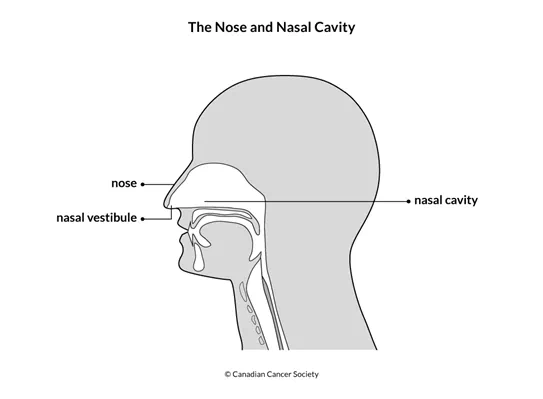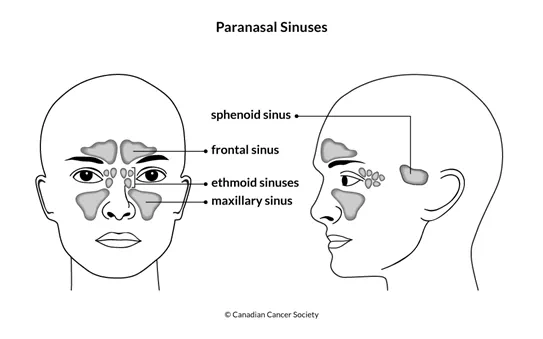The nasal cavity and paranasal sinuses
The nasal cavity and the paranasal sinuses are part of the body's respiratory system.

Structure of the nasal cavity
The nose is the beginning of the respiratory tract. The nostrils are the 2 openings in the nose.
The nasal vestibule is the area just inside the nostril. It is supported by cartilage and lined with skin and coarse hairs. These hairs help trap large particles such as sand, dust and even insects to prevent them from entering the nasal cavity.
The nasal vestibule opens into the nasal cavity. The nasal cavity is divided into left and right sides by a wall of cartilage and bone (called the nasal septum). Air moves through these passageways when you breathe. The nasal cavity is above the roof of the mouth (called the palate) and surrounded by the paranasal sinuses. It joins with the nasopharynx, which is the upper part of the throat (pharynx) at the back of the mouth.
Structure of the paranasal sinuses
Paranasal means around or near the nose. The paranasal sinuses are hollow spaces filled with air, located around the nose inside the skull. The paranasal sinuses are connected to one another and to the nasal cavity.
Types of paranasal sinuses
There are 4 pairs of paranasal sinuses.

The maxillary sinuses are in the maxilla (the upper jaw), on each side of the nose, behind the cheeks and below the eyes. They are shaped like pyramids. They are the largest of the paranasal sinuses.
The frontal sinuses are in the frontal bone, above the nose and behind the eyebrows. They are 2 hollow spaces divided by a thin wall of bone.
The ethmoid sinuses are small hollow spaces in the ethmoid bone, on the bridge of the nose, above the nasal cavity and between the eyes. They can vary in number and size.
The sphenoid sinus is in the sphenoid bone, which is deep in the skull. It is behind the ethmoid sinuses and nasal cavity. It is separated into a left and right sinus by a thin wall of bone.
Types of cells in the nasal cavity and paranasal sinuses
The nasal cavity and the paranasal sinuses are lined by a layer of tissue that produces mucus (called the mucous membrane, or the mucosa). The mucous membrane has many types of cells, including:
- squamous cells, which make up most of the mucous membrane
- gland cells, which make mucus and other fluids
- nerve cells, which are responsible for the sense of smell in the nose
- immune cells, which help fight infection
Other nearby structures
Other structures near the nasal cavity and paranasal sinuses include:
- lymph nodes in the neck (called cervical lymph nodes)
- nerves, which control swallowing, vision, smell, hearing and eye movement
- bones of the skull, such as the bones that make up the eye socket (called the orbit), sphenoid bone, ethmoid bone and maxilla
What the nasal cavity and paranasal sinuses do
The main functions of the nasal cavity and paranasal sinuses are to:
- filter, warm and moisten the air you breathe
- give you a sense of smell
- make mucus
- lighten the weight of the skull
- vibrate (resonate), which helps to give your voice a unique sound
- protect the brain from injury
